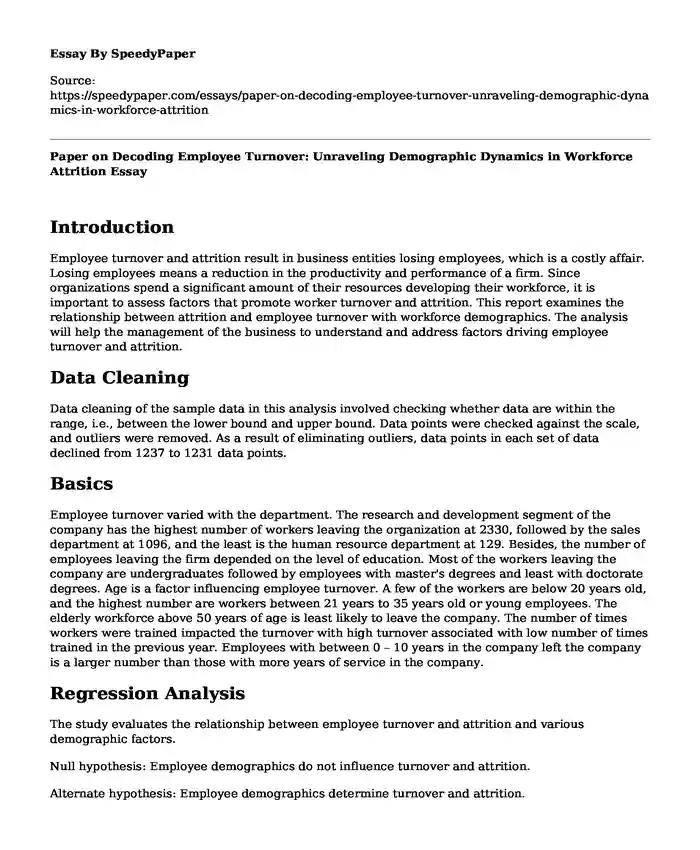
| Type of paper: | Essay |
| Categories: | Employment Job |
| Pages: | 3 |
| Wordcount: | 622 words |
Introduction
Employee turnover and attrition result in business entities losing employees, which is a costly affair. Losing employees means a reduction in the productivity and performance of a firm. Since organizations spend a significant amount of their resources developing their workforce, it is important to assess factors that promote worker turnover and attrition. This report examines the relationship between attrition and employee turnover with workforce demographics. The analysis will help the management of the business to understand and address factors driving employee turnover and attrition.
Data Cleaning
Data cleaning of the sample data in this analysis involved checking whether data are within the range, i.e., between the lower bound and upper bound. Data points were checked against the scale, and outliers were removed. As a result of eliminating outliers, data points in each set of data declined from 1237 to 1231 data points.
Basics
Employee turnover varied with the department. The research and development segment of the company has the highest number of workers leaving the organization at 2330, followed by the sales department at 1096, and the least is the human resource department at 129. Besides, the number of employees leaving the firm depended on the level of education. Most of the workers leaving the company are undergraduates followed by employees with master's degrees and least with doctorate degrees. Age is a factor influencing employee turnover. A few of the workers are below 20 years old, and the highest number are workers between 21 years to 35 years old or young employees. The elderly workforce above 50 years of age is least likely to leave the company. The number of times workers were trained impacted the turnover with high turnover associated with low number of times trained in the previous year. Employees with between 0 – 10 years in the company left the company is a larger number than those with more years of service in the company.
Regression Analysis
The study evaluates the relationship between employee turnover and attrition and various demographic factors.
Null hypothesis: Employee demographics do not influence turnover and attrition.
Alternate hypothesis: Employee demographics determine turnover and attrition.
The regression coefficient and r-squared show a weak association between the independent and dependent variables. Some independent variables demonstrate a negative relationship with employee turnover and attrition. For instance, the hourly rate, job level, monthly income, percentage salary hike, and total working years indicate a negative linkage with workers’ turnover. It means that when one variable increases the other decreases. When the salary rises by $1, the turnover declines insignificantly. In the case of attrition, the study demonstrates that some variables relate to attrition negatively and positively for others. Some of the factors that reduce are salary hikes, stock options level, total working years, and training times per year. Some variables with a p-value less than the significance level (0.05) are gender hourly rate, job level, and job role resulting in rejecting the null hypotheses. This means that these variables influence employee turnover. The majority of predictor variables lowering turnover are the same reducing attrition in the company. Some of the variables linked to turnover and attrition for turnover and attrition include the number of companies worked, years at the company, distance from home, and education. According to the analysis, the most likely predictors of employee turnover are job satisfaction, job involvement, number of business travels, and overtime. These are factors showing a strong linkage to turnover.
Conclusion
The survey shows that some demographics have more weight in predicting employee turnover than others. While some variables influence turnover and attrition positively, others help in minimizing their occurrence. Demographic factors to predict turnover are job satisfaction, job involvement, number of business travels, and overtime. Lowering turnover will require the management to engage workers more in the job and raise their motivation.
Cite this page
Paper on Decoding Employee Turnover: Unraveling Demographic Dynamics in Workforce Attrition. (2024, Jan 27). Retrieved from https://speedypaper.com/essays/paper-on-decoding-employee-turnover-unraveling-demographic-dynamics-in-workforce-attrition
Request Removal
If you are the original author of this essay and no longer wish to have it published on the SpeedyPaper website, please click below to request its removal:
- Curriculum Vitae Essay Sample
- Essay Example on Isolationism and Internationalism
- Free Essay on Whether Flexible Working Hours Foster Teamwork
- Essay Sample on America's Economics Demand for Coal, Steel and Aluminum
- Essay Sample on Effects of the Internet and WWW on World Economy
- Essay Example for Students: American Economic Crisis
- Paper Example. Nurses burnout
Popular categories




